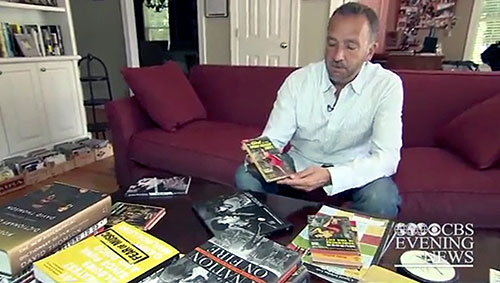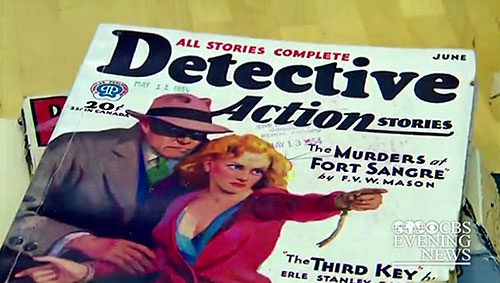Speaking from a journalism career of more than 25 years (and from being a pulp fan even longer), I can safely say that CBS News blew it in a report on the Library of Congress‘ efforts to preserve its pulp magazines.
As a reporter, the first thing you want to do is make sure you understand the subject of your story.
I’m referring to a report by CBS News’ Chip Reid from last October that’s making the round recently on Facebook. (I’m sorry I can’t embed the video in the post; CBS News won’t allow it. You’ll have to visit the Dailymotion website to watch it.)
The report opens with Jeanne Drewes, chief of the Binding and Collections Care Division and program manager for mass deacidification at the Library. She displays pulp magazines and does a good job of explaining the problems with the cheap pulpwood paper that they were printed on 60 or more years ago.
Reid should have talked with her in more detail so that he understood what he was reporting: pulp magazine preservation — not “pulp fiction” preservation. The editors and Sunday evening anchor Jeff Glor didn’t get it either.
Next up in Reid’s report is a detective-fiction author and a writer for TV’s “The Wire,” George Pelecanos.
Pelecanos may be an excellent writer, but he was the wrong expert to talk about pulp magazine preservation. He discusses paperback books from the 1950s throughout his portions on the report.
Yes, those paperbacks contain what is often referred to as pulp fiction, but in this instance, that is irrelevent.
To cap it all off, the final image in the video is of a kid reading an issue of Altas’ Menace comic book from 1954 — certainly not a pulp magazine either.
The report conflates pulp magazines, paperback books and, eventually, comic books into “pulp magazines.” But worse than that, viewers of the report come away thinking that pulp magazines contained only hard-boiled fiction.
The report doesn’t reflect the broad range of fiction found in the pulps.

As “pulp fiction fan” Pelecanos holds a 1950s paperback, he says: “Pulp novels were about people who stumble, who go to work everyday. They don’t usually win big in the end, but they have these moments of inglorious redemption.”
Reid continues his narration over scenes from World War II: “The writing sprang from the minds of men and women traumatized by war.”
Then Pelecanos returns: “They’d seen a lot of horrible things, seen a lot of death. They came back and started writing these very, very dark books. Chandler when describing this genre famously said, ‘The streets were dark with something more than night.’ ”
As pulp fans, we know that those were only a portion of the stories told in the pulp magazines. And that by the time World War II ended, the glory days of the pulp magazines were past. Sadly, viewers of this CBS News report didn’t learn any of this.
Fortunately, some shots of actual pulp magazines — Star Magazine, Ten-Story Love, Detective Action Stories, Dime Detective, New Detective Magazine, Rangeland Romances, Wonder Stories — illustrate the report. At least CBS News was wise enough to show these pulps provided by the Library. Too bad they didn’t leave it at that.




I can only shake my head in dismay every time I hear something like this. The history of the pulp magazines become muddier every year with all the so-called knowledgeable people reporting something about them. Some day all this hog wash will be taken for the truth. Sad.
I agree on all counts with William’s post and Tom’s comment above. The reporter should have done research and realized there is more to the pulps than just crime fiction. Tarantino’s Pulp Fiction stereotype still exists it seems.
I would have rather they stayed with the lady at the Library of Congress, she seemed much more knowledgeable than that writer who was talking about crime fiction only. Plus they could have shown more pulp magazine covers.